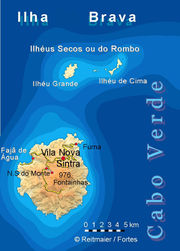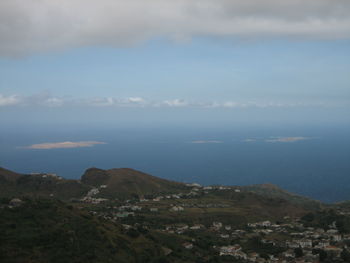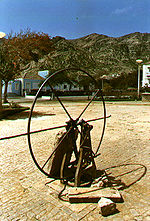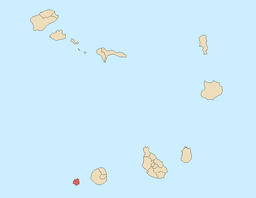Brava, Cape Verde
| Native name: Dja Braba Sobriquet: Ilha das flores (island of the flowers) |
|
|---|---|
 |
|
 |
|
| Geography | |
| Location | Atlantic Ocean |
| Area | 67 square kilometres (26 sq mi) |
| Length | 24 kilometres (15 mi) |
| Width | 16 kilometres (9.9 mi) |
| Highest elevation | 976 metres (3,202 ft) |
| Highest point | Monte Fontainhas |
| Country | |
|
Cape Verde
|
|
| Concelhos (Municipalities) | Brava |
| Largest city | Nova Sintra |
Brava is an island in Cape Verde. It is the smallest inhabited island, but at the same time the greenest, of Cape Verde, in the Sotavento group. First settled in the 1540s, its population grew after Mount Fogo on neighbouring Fogo erupted in 1675. Its main industry was long whaling, but the island is now primarily agricultural.
The island also constitutes the entire municipality of Brava, which has two parishes, São João Baptista and Nossa Senhora do Monte.
Contents |
Geography
Practically the whole island is a stratovolcano. It lies in the lee of the enormous Fogo volcano. Volcanic activity on the island has been mainly located along three sets of lineaments, which all intersect at the crest of ground that forms the highest part of the island. Brava has no documented historical eruptions, but its youthful volcanic morphology and the fact that earthquake swarms still occur indicate the potential for future eruptions.
North of Brava are two small islands with 4 islets, 3 of them are west of Ilhéu de Cima. The islands are Ilhéu Grande.

The island's main town is Vila Nova Sintra. The island has schools, a lyceum, a gymnasia, churches, and a square (praça) in honour of the famous musician Eugénio Tavares.

All of the five villages lie north of the mountaintop, which has four main roads including Furna - Vila Nova Sintra and Fajã de Agua and south to Nova Sintra do Monte and slightly south of the mountaintop. The two large islands north of Brava are uninhabited. The mountain valleys dominate the south, the east and the west. The north has a few valleys.
Precipitation arrives from the trade wind clouds. The island is covered with a leeward cloud so that evaporation is reduced and the vegetation is more abundant. Key inhabited places include the village of Vila Nova Sintra. The village of Furna has a commercial port.
Settlements
- Cachaço
- Campo Baixo
- Cova Joana
- Cova Rodela
- Fajã de Agua
- Furna
- Lime Doce
- Mato Grande
- Nossa Senhora do Monte
- Santa Bárbara
- Tantum
- Vila Nova Sintra
Geographical features
| Brava | |
| Municipality | |
| Island | Brava |
|---|---|
| Seat town | Nova Sintra |
| Area | 67 km² (26 sq mi) |
| Population | 6,426 (2005[1]) |
| Density | 96 / km² (249 / sq mi) |
| ISO 3166-2 code | CV-BR |
| CGN-CV code | 91 |
| Demonym | Bravense m, ~s pl |
 |
|
| Website: http://www.bravanews.com | |
|
|
Transport

The airport, inaugurated in 1992, was closed because of the strong wind. The airline service ended in 2004. Brava can be reached by ferry from Praia, the capital of Cabo Verde, once a week and from Fogo, the neighbouring island, twice or thrice a week. The main harbour is Furna on the East coast where busses and taxis are waiting when the ferrry arrives. On Brava you can reach the villages by "Aluguer" bus. There is no fixed schedule, as the aluguers wait until enough passengers have come. A few taxis are available as well.
History
Brava was discovered in 1462 by the Portuguese in 1462 and the first settlement was founded in 1573. The slave trade was common in Cidade Velha. The persons that were from Madeira and Minho in Northern Portugal did not participate any longer. In 1680, the inhabitants fled from the nearby large island of Fogo after the volcano erupted and lava began to flow and to devastate. In the 17th and the 18th centuries, pirates raided the bays of the island and continued until the 19th century when whaling was common from the ships of Europe and North America. Emigration began as the whaleships sailed people from Brava to the northeastern part of North America especially along the Eastern Seaboard. Most of the immigrants from Brava settled in Boston, Massachusetts, Providence, Rhode Island and New Bedford, Massachusetts. Brava most famous son is the musician Eugénio Tavares, which he used the traditional morna and was written in Cape Verdean Creole. A statue dedicated to Eugénio Tavares is in the main square of Vila Nova Sintra and is encircled with a beautiful garden with trees, sunflowers, flowers, grass and other types of plants. Other notable persons includes Hermano da Pina and Armando da Pina who lives in the Eastern Seaboard which has his ancestry to his parents in Brava.
Population
Brava is the least populated island of the inhabited Cape Verde islands. The population has been decreasing over the years, primarily due to the migration to other islands and emigration (especially to the United States).
Demography
| Population of Brava, Cape Verde (1940—2010) | |||||||
|---|---|---|---|---|---|---|---|
| 1940[2] | 1950[2] | 1960[2] | 1970[2] | 1980[2] | 1990[2] | 2000[3] | 2010[4] |
| 8528 | 7937 | 8625 | 7756 | 6985 | 6975 | 6804 | 6043 |
Economy
The main economy of the island is agricultural, related to irrigation and fishing (the island's main production). Trading and private households depend on income from Cape Verdean residents from North America.
Brava never had a lot of tourism. Tourism slowly boomed. The island is unsuitable for beach tourism because the steep shoreline allows few beaches.
Sites of interest
- Vila Nova Sintra, an idyllic town with a museum, traditional portuguese architecture, several churches and many shops.
- Vinagre (Portuguese for Vinegar)
- Fajã de Agua, a small harbour on the West coast with a natural swimming pool, called "piscina".
- Nossa Senhora do Monte, a village in the mountains with a pilgrimage church.
- There are many beautiful walking tracks on the island.
Sporting teams
- Académica
- Benfica
- Corôa
- Morabeza
- No Pintcha
- Sporting
Persons
- Eugénio Tavares – writer and composer
References
- ↑ Source: Instituto Nacional de Estatísticas.
- ↑ 2.0 2.1 2.2 2.3 2.4 2.5 Source: Statoids
- ↑ Source: Instituto Nacional de Estatísticas.
- ↑ Source: projection to 2010 from the Instituto Nacional de Estatísticas.
External links
- Brava News - News directly from Brava
- Brava island - caboverde.com
- Brava, Cape Verde Islands - University of Massachusetts
- Photos of Brava
- Brava Island, Cape Verde - Cape Verde Island Guide
|
|||||||||||||
|
||||||||